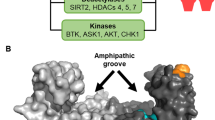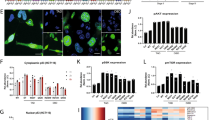Abstract
Although still controversial, the presence of mutant p53 in cancer cells may result in more aggressive tumors and correspondingly worse outcomes. The means by which mutant p53 exerts such pro-oncogenic activity are currently under extensive investigation and different models have been proposed. We focus here on a proposed mechanism by which a subset of tumor-derived p53 mutants physically interact with p53 family members, p63 and p73, and negatively regulate their proapoptotic function. Both cell-based assays and knock-in mice expressing mutant forms of p53 support this model. As more than half of human tumors harbor mutant forms of p53 protein, approaches aimed at disrupting the pathological interactions among p53 family members might be of clinical value.
This is a preview of subscription content, access via your institution
Access options
Subscribe to this journal
Receive 50 print issues and online access
$259.00 per year
only $5.18 per issue
Buy this article
- Purchase on Springer Link
- Instant access to full article PDF
Prices may be subject to local taxes which are calculated during checkout

Similar content being viewed by others
References
Barbieri CE, Tang LJ, Brown KA, Pietenpol JA . (2006). Loss of p63 leads to increased cell migration and up-regulation of genes involved in invasion and metastasis. Cancer Res 66: 7589–7597.
Bensaad K, Le Bras M, Unsal K, Strano S, Blandino G, Tominaga O et al. (2003). Change of conformation of the DNA-binding domain of p53 is the only key element for binding of and interference with p73. J Biol Chem 278: 10546–10555.
Bergamaschi D, Gasco M, Hiller L, Sullivan A, Syed N, Trigiante G et al. (2003). p53 polymorphism influences response in cancer chemotherapy via modulation of p73-dependent apoptosis. Cancer Cell 3: 387–402.
Bergamaschi D, Samuels Y, Jin B, Duraisingham S, Crook T, Lu X . (2004). ASPP1 and ASPP2: common activators of p53 family members. Mol Cell Biol 24: 1341–1350.
Brunner HG, Hamel BC, Bokhoven HvH . (2002). P63 gene mutations and human developmental syndromes. Am J Med Genet 112: 284–290.
Chipuk JE, Green DR . (2006). Dissecting p53-dependent apoptosis. Cell Death Differ 13: 994–1002.
Cho Y, Gorina S, Jeffrey PD, Pavletich NP . (1994). Crystal structure of a p53 tumor suppressor-DNA complex: understanding tumorigenic mutations. Science 265: 346–355.
Davison TS, Vagner C, Kaghad M, Ayed A, Caput D, Arrowsmith CH . (1999). p73 and p63 are homotetramers capable of weak heterotypic interactions with each other but not with p53. J Biol Chem 274: 18709–18714.
Di Agostino S, Strano S, Emiliozzi V, Zerbini V, Mottolese M, Sacchi A et al. (2006). Gain of function of mutant p53: The mutant p53/NF-Y protein complex reveals an aberrant transcriptional mechanism of cell cycle regulation. Cancer Cell 10: 191–202.
Di Como CJ, Gaiddon C, Prives C . (1999). p73 function is inhibited by tumor-derived p53 mutants in mammalian cells. Mol Cell Biol 19: 1438–1449.
Flores ER, Sengupta S, Miller JB, Newman JJ, Bronson R, Crowley D et al. (2005). Tumor predisposition in mice mutant for p63 and p73: evidence for broader tumor suppressor functions for the p53 family. Cancer Cell 7: 363–373.
Flores ER, Tsai KY, Crowley D, Sengupta S, Yang A, McKeon F et al. (2002). p63 and p73 are required for p53-dependent apoptosis in response to DNA damage. Nature 416: 560–564.
Gaiddon C, Lokshin M, Ahn J, Zhang T, Prives C . (2001). A subset of tumor-derived mutant forms of p53 down-regulate p63 and p73 through a direct interaction with the p53 core domain. Mol Cell Biol 21: 1874–1887.
Gannon JV, Greaves R, Iggo R, Lane DP . (1990). Activating mutations in p53 produce a common conformational effect. A monoclonal antibody specific for the mutant form. EMBO J 9: 1595–1602.
Gorina S, Pavletich NP . (1996). Structure of the p53 tumor suppressor bound to the ankyrin and SH3 domains of 53BP2. Science 274: 1001–1005.
Gressner O, Schilling T, Lorenz K, Schulze Schleithoff E, Koch A, Schulze-Bergkamen H et al. (2005). TAp63alpha induces apoptosis by activating signaling via death receptors and mitochondria. EMBO J 24: 2458–2471.
Hibi K, Trink B, Patturajan M, Westra WH, Caballero OL, Hill DE et al. (2000). AIS is an oncogene amplified in squamous cell carcinoma. Proc Natl Acad Sci USA 97: 5462–5467.
Irwin MS, Kondo K, Marin MC, Cheng LS, Hahn WC, Kaelin WG . (2003). Chemosensitivity linked to p73 function. Cancer Cell 3: 403–410.
Kaghad M, Bonnet H, Yang A, Creancier L, Biscan JC, Valent A et al. (1997). Monoallelically expressed gene related to p53 at 1p36, a region frequently deleted in neuroblastoma and other human cancers. Cell 90: 809–819.
Lang GA, Iwakuma T, Suh YA, Liu G, Rao VA, Parant JM et al. (2004). Gain of function of a p53 hot spot mutation in a mouse model of Li–Fraumeni syndrome. Cell 119: 861–872.
Lanza M, Marinari B, Papoutsaki M, Giustizieri ML, D'Alessandra Y, Chimenti S et al. (2006). Cross-talks in the p53 family: DeltaNp63 is an anti-apoptotic target for DeltaNp73alpha and p53 gain-of-function mutants. Cell Cycle 5.
Laptenko O, Prives C . (2006). Transcriptional regulation by p53: one protein, many possibilities. Cell Death Differ 13: 951–961.
Lokshin M, Li Y, Gaiddon C, Prives C . (2007). p53 and p73 display common and distinct requirements for sequence specific binding to DNA. Nucleic Acids Res 35: 340–352.
Lokshin M, Tanaka T, Prives C . (2005). Transcriptional regulation by p53 and p73. Cold Spring Harb Symp Quant Biol 70: 121–128.
Marin MC, Jost CA, Brooks LA, Irwin MS, O'Nions J, Tidy JA et al. (2000). A common polymorphism acts as an intragenic modifier of mutant p53 behaviour. Nat Genet 25: 47–54.
Murray-Zmijewski F, Lane DP, Bourdon JC . (2006). p53/p63/p73 isoforms: an orchestra of isoforms to harmonise cell differentiation and response to stress. Cell Death Differ 13: 962–972.
Olive KP, Tuveson DA, Ruhe ZC, Yin B, Willis NA, Bronson RT et al. (2004). Mutant p53 gain of function in two mouse models of Li–Fraumeni syndrome. Cell 119: 847–860.
Osada M, Ohba M, Kawahara C, Ishioka C, Kanamaru R, Katoh I et al. (1998). Cloning and functional analysis of human p51, which structurally and functionally resembles p53. Nat Med 4: 839–843.
Resnick MA, Inga A . (2003). Functional mutants of the sequence-specific transcription factor p53 and implications for master genes of diversity. Proc Natl Acad Sci USA 100: 9934–9939.
Rocco JW, Leong CO, Kuperwasser N, DeYoung MP, Ellisen LW . (2006). p63 mediates survival in squamous cell carcinoma by suppression of p73-dependent apoptosis. Cancer Cell 9: 45–56.
Samuels-Lev Y, O'Connor DJ, Bergamaschi D, Trigiante G, Hsieh JK, Zhong S et al. (2001). ASPP proteins specifically stimulate the apoptotic function of p53. Mol Cell 8: 781–794.
Strano S, Fontemaggi G, Costanzo A, Rizzo MG, Monti O, Baccarini A et al. (2002). Physical interaction with human tumor-derived p53 mutants inhibits p63 activities. J Biol Chem 277: 18817–18826.
Strano S, Munarriz E, Rossi M, Castagnoli L, Shaul Y, Sacchi A et al. (2001). Physical interaction with Yes-associated protein enhances p73 transcriptional activity. J Biol Chem 276: 15164–15173.
Strano S, Munarriz E, Rossi M, Cristofanelli B, Shaul Y, Castagnoli L et al. (2000). Physical and functional interaction between p53 mutants and different isoforms of p73. J Biol Chem 275: 29503–29512.
Urist M, Tanaka T, Poyurovsky MV, Prives C . (2004). p73 induction after DNA damage is regulated by checkpoint kinases Chk1 and Chk2. Genes Dev 18: 3041–3054.
van Bokhoven H, Brunner HG . (2002). Splitting p63. Am J Hum Genet 71: 1–13.
Vogelstein B, Lane D, Levine AJ . (2000). Surfing the p53 network. Nature 408: 307–310.
Vousden KH, Lu X . (2002). Live or let die: the cell's response to p53. Nat Rev Cancer 2: 594–604.
Willis AC, Pipes T, Zhu J, Chen X . (2003). p73 can suppress the proliferation of cells that express mutant p53. Oncogene 22: 5481–5495.
Wiman KG . (2006). Strategies for therapeutic targeting of the p53 pathway in cancer. Cell Death Differ 13: 921–926.
Wong KB, DeDecker BS, Freund SM, Proctor MR, Bycroft M, Fersht AR . (1999). Hot-spot mutants of p53 core domain evince characteristic local structural changes. Proc Natl Acad Sci USA 96: 8438–8442.
Wu G, Nomoto S, Hoque MO, Dracheva T, Osada M, Lee CC et al. (2003). DeltaNp63alpha and TAp63alpha regulate transcription of genes with distinct biological functions in cancer and development. Cancer Res 63: 2351–2357.
Yang A, Kaghad M, Caput D, McKeon F . (2002). On the shoulders of giants: p63, p73 and the rise of p53. Trends Genet 18: 90–95.
Yang A, Kaghad M, Wang Y, Gillett E, Fleming MD, Dotsch V et al. (1998). p63, a p53 homolog at 3q27–29, encodes multiple products with transactivating, death-inducing, and dominant-negative activities. Mol Cell 2: 305–316.
Zeng SX, Dai MS, Keller DM, Lu H . (2002). SSRP1 functions as a co-activator of the transcriptional activator p63. EMBO J 21: 5487–5497.
Author information
Authors and Affiliations
Corresponding author
Rights and permissions
About this article
Cite this article
Li, Y., Prives, C. Are interactions with p63 and p73 involved in mutant p53 gain of oncogenic function?. Oncogene 26, 2220–2225 (2007). https://doi.org/10.1038/sj.onc.1210311
Published:
Issue Date:
DOI: https://doi.org/10.1038/sj.onc.1210311
Keywords
This article is cited by
-
Mutant p53 gains oncogenic functions through a chromosomal instability-induced cytosolic DNA response
Nature Communications (2024)
-
microRNA-205 represses breast cancer metastasis by perturbing the rab coupling protein [RCP]-mediated integrin β1 recycling on the membrane
Apoptosis (2024)
-
Regulation of P53 signaling in breast cancer by the E3 ubiquitin ligase RNF187
Cell Death & Disease (2022)
-
p73 isoforms meet evolution of metastasis
Cancer and Metastasis Reviews (2022)
-
APR-246 induces apoptosis and enhances chemo-sensitivity via activation of ROS and TAp73-Noxa signal in oesophageal squamous cell cancer with TP53 missense mutation
British Journal of Cancer (2021)



